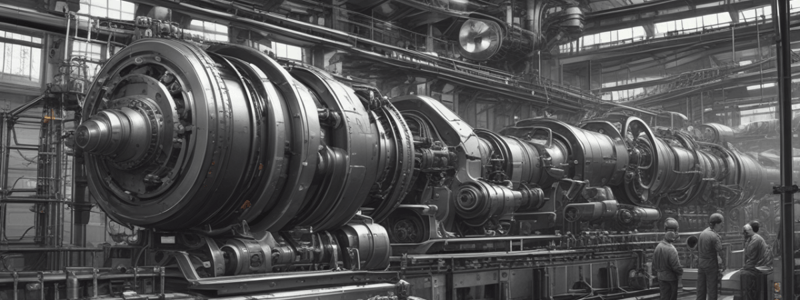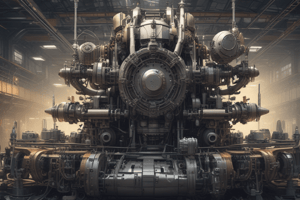Podcast
Questions and Answers
What is the primary advantage of closed die forging over open die forging?
What is the primary advantage of closed die forging over open die forging?
- Increased productivity
- Multidirectional unbroken grain flow (correct)
- Better surface finish
- Reduced material wastage
What is the process where the volume of the workpiece is equal to the volume of the die cavity, with no requirement of flash arrangement?
What is the process where the volume of the workpiece is equal to the volume of the die cavity, with no requirement of flash arrangement?
- Combined extrusion-forging
- Closed die forging
- Flashless forging (correct)
- Open die forging
What is the primary advantage of combined extrusion-forging over conventional metal extrusion and forging?
What is the primary advantage of combined extrusion-forging over conventional metal extrusion and forging?
- Increased material wastage
- Reduced capital investment (correct)
- Improved mechanical properties
- Better surface finish
What is the primary reason for the significance of combined extrusion-forging in modern industry?
What is the primary reason for the significance of combined extrusion-forging in modern industry?
What is the primary benefit of cold CEF over hot CEF?
What is the primary benefit of cold CEF over hot CEF?
What is the primary role of metals like aluminium and aluminium based alloys in CEF and CE processes?
What is the primary role of metals like aluminium and aluminium based alloys in CEF and CE processes?
What type of extrusion process eliminates frictional force between the billet and container interface?
What type of extrusion process eliminates frictional force between the billet and container interface?
In which type of extrusion process does the material flow perpendicularly to the direction of the punch movement?
In which type of extrusion process does the material flow perpendicularly to the direction of the punch movement?
What type of forging process involves the operation of increasing the cross section at the expense of length?
What type of forging process involves the operation of increasing the cross section at the expense of length?
In which type of forging process is the work compressed between two flat dies, allowing metal to flow freely laterally with minimum constraint?
In which type of forging process is the work compressed between two flat dies, allowing metal to flow freely laterally with minimum constraint?
What type of extrusion process uses a hydrostatic fluid to extrude the billet through the die?
What type of extrusion process uses a hydrostatic fluid to extrude the billet through the die?
Which type of forging process involves the application of a gradual load?
Which type of forging process involves the application of a gradual load?
What is the primary advantage of metal forming over other manufacturing processes?
What is the primary advantage of metal forming over other manufacturing processes?
What is the minimum force required to obtain deformation in metal forming?
What is the minimum force required to obtain deformation in metal forming?
Which of the following is NOT a type of bulk metal deformation process?
Which of the following is NOT a type of bulk metal deformation process?
What is the advantage of cold forging and extrusion processes compared to hot and warm processes?
What is the advantage of cold forging and extrusion processes compared to hot and warm processes?
How many types of extrusion processes are classified based on the relative movement of the punch and extruded product?
How many types of extrusion processes are classified based on the relative movement of the punch and extruded product?
What is the temperature range at which extrusion and forging processes can be carried out?
What is the temperature range at which extrusion and forging processes can be carried out?
Which of the following metal spinning methods is best suited for thin plates and sheets of aluminum and other soft metals?
Which of the following metal spinning methods is best suited for thin plates and sheets of aluminum and other soft metals?
What is the primary purpose of using a back-up support in hot spinning?
What is the primary purpose of using a back-up support in hot spinning?
What is the main difference between hot spinning and cold spinning?
What is the main difference between hot spinning and cold spinning?
Which of the following processes is used to reduce the cross-section of a wire by pulling it through a die?
Which of the following processes is used to reduce the cross-section of a wire by pulling it through a die?
What is the primary purpose of deep drawing?
What is the primary purpose of deep drawing?
Which of the following processes is used to decrease the diameter of a tube and improve its surface finish?
Which of the following processes is used to decrease the diameter of a tube and improve its surface finish?
What is the primary reason for using high-grade alloy steels with coatings for dies?
What is the primary reason for using high-grade alloy steels with coatings for dies?
What is the main advantage of using curved dies over flat faced dies?
What is the main advantage of using curved dies over flat faced dies?
What is the primary purpose of metal spinning process?
What is the primary purpose of metal spinning process?
What is the advantage of metal spinning over stamping and deep drawing processes?
What is the advantage of metal spinning over stamping and deep drawing processes?
What is the main reason for using carbides as die materials?
What is the main reason for using carbides as die materials?
What is the primary benefit of using tool steels for dies?
What is the primary benefit of using tool steels for dies?
What is the primary reason for the application of metal forming in major automobile and aircraft industries?
What is the primary reason for the application of metal forming in major automobile and aircraft industries?
Which of the following is a classification of metal forming processes?
Which of the following is a classification of metal forming processes?
What is the primary advantage of extrusion and forging processes over other conventional manufacturing processes?
What is the primary advantage of extrusion and forging processes over other conventional manufacturing processes?
What is the primary reason for the application of cold extrusion and forging processes?
What is the primary reason for the application of cold extrusion and forging processes?
Which of the following is a type of extrusion process?
Which of the following is a type of extrusion process?
What is the primary characteristic of forward extrusion process?
What is the primary characteristic of forward extrusion process?
What is the primary advantage of indirect extrusion process?
What is the primary advantage of indirect extrusion process?
What is the primary characteristic of radial extrusion process?
What is the primary characteristic of radial extrusion process?
What is the primary application of impact extrusion process?
What is the primary application of impact extrusion process?
What is the primary reason for the classification of metal forming into bulk metal working and sheet metal working processes?
What is the primary reason for the classification of metal forming into bulk metal working and sheet metal working processes?
Flashcards are hidden until you start studying
Study Notes
Conventional Manufacturing Processes
- Metal forming has advantages over other manufacturing processes due to high precision, minimal material wastage, and better mechanical properties.
- Metal forming is a process of plastically deforming a metal block to a desired geometry by applying a force higher than the yield strength of the material.
Bulk Metal Working Processes
- Classified into four types: rolling, forging, extrusion, and drawing.
- Forging and extrusion are frequently used forming processes since the 18th century.
Extrusion and Forging Processes
- Can be carried out under three working temperatures: hot, cold, and warm linked to recrystalization temperature.
- Cold forging and extrusion processes have more advantages compared to hot and warm processes with respect to geometrical accuracy, surface finish, and mechanical properties of the final component.
Extrusion Processes
- Classified into four types depending on the relative movement of the punch and extruded product:
- Forward (Direct) extrusion: most common method used in industries to manufacture long products of uniform cross-section.
- Backward (Indirect) extrusion: billet does not move relative to the container, eliminating frictional force between billet and container interface.
- Radial (Lateral) extrusion: material flow perpendicularly to the direction of the punch movement.
- Impact extrusion: similar to backward/indirect extrusion process, with a punch running down quickly on the blank to obtain a tubular section.
Forging Processes
- Classified into:
- Upset forging: force applied parallel to the length direction to increase the cross-section at the expense of length.
- Drawing out: force applied perpendicular to the length axis to decrease the cross-section area.
- Open die forging: work is compressed between two flat dies, allowing metal to flow freely laterally.
- Closed die or Impression die forging: work piece is compressed between two die halves to obtain a multidirectional unbroken grain flow.
- Flashless forging: volume of the workpiece is equal to the volume of the die cavity, with no requirement of flash arrangement.
Combined Extrusion Forging Processes
- Combined forward and backward extrusion (CE): simultaneous backward and forward extrusion.
- Combined extrusion-forging (CEF): both extrusion and forging take place simultaneously to obtain a complex shape.
Dies
- Types of dies:
- Flat faced dies: most preferred in the industry due to its simple design and low cost.
- Taper or conical dies: have an entrance angle for metal flow.
- Curved dies: minimize friction loss and redundant work.
Metal Spinning
- A process of forming rotationally symmetrical hollow parts from circular blanks.
- Used to produce cone-shaped, elliptical, or other concave or convex parts.
- Metal spinning yields pots, pans, vases, lamp shades, musical-instrument parts, and trophies.
Drawing
- A process of cold forming a flat precut metal blank into a hollow vessel.
- Various forms produced include cylindrical, box-shaped, and irregular shapes.
- Used to produce cups, cans, pans, cylinders, domes, hemispheres, tubes, and hoppers.
Wire Drawing
- A metalworking process used to reduce the cross-section of a wire by pulling the wire through a single, or series of, drawing die(s).
- Used to produce electrical wiring, cables, tension-loaded structural components, springs, and paper clips.
Tube Drawing
-
A process similar to bar drawing, used to decrease the diameter, improve surface finish, and improve dimensional accuracy of tubes.
-
A mandrel may or may not be used depending on the specific process used.### Types of Extrusion
-
Direct extrusion: billet moves relative to the container
-
Indirect (Backward or Reverted) extrusion: billet does not move relative to the container, die fixed on a hollow ram pushes against the billet, eliminating frictional force between billet and container interface
-
Radial (Lateral) extrusion: material flow perpendicularly to the direction of the punch movement, requiring additional power to overcome friction at the die-billet interface, commonly used for production of flange type components
-
Impact extrusion: similar to indirect extrusion, punch runs down quickly on the blank, resulting in a tubular section, used to produce toothpaste tubes
-
Hydrostatic extrusion: billet is extruded through the die by the action of a hydrostatic liquid pressure medium, rather than direct application of load with a ram, allows for extrusion of brittle materials, can be done hot, warm, or cold
Studying That Suits You
Use AI to generate personalized quizzes and flashcards to suit your learning preferences.





